Choosing the right meat grinder plate is crucial for achieving the desired texture in your ground meat. Whether you're making sausages, burgers, or finely ground meat for recipes, understanding meat grinder plate sizes is key. This comprehensive guide will walk you through everything you need to know about meat grinder plates, helping you select the perfect one for your culinary needs.
What are Meat Grinder Plates?
Meat grinder plates, also known as grinding plates or plates, are the essential component that determines the final consistency of your ground meat. They are typically made of stainless steel and feature a series of holes of varying sizes. The size of these holes directly impacts the coarseness or fineness of the ground meat. Larger holes produce coarser ground meat, while smaller holes result in finer textures.
Understanding Meat Grinder Plate Sizes
Meat grinder plate sizes are usually measured in millimeters (mm) and represent the diameter of the holes. Common sizes range from 3mm to 12mm, although some grinders may offer plates with even larger or smaller holes. You won't find a universally standardized chart across all brands, as manufacturers may use slightly different measurements. However, the general principle remains the same.
Common Plate Hole Sizes and Their Uses:
-
3mm - 6mm: These plates create finely ground meat, ideal for sausages, bologna, and recipes requiring a smooth texture. This is a popular choice for many home cooks.
-
8mm - 10mm: This range produces a medium grind, suitable for hamburgers, meatballs, and meatloaf. It offers a good balance between texture and ease of grinding.
-
12mm+: These plates are best for coarse grinding, often used for making stew meat or for grinding tougher cuts of meat. They are also useful for quickly processing larger quantities of meat.
What Plate Size Should I Use?
The optimal meat grinder plate size depends entirely on your intended use. Consider the following:
-
Type of Meat: Tougher cuts of meat may require a coarser grind to process efficiently. Leaner meats can tolerate a finer grind.
-
Desired Texture: Do you need a fine grind for sausages or a coarser grind for chili? The desired texture dictates the plate size.
-
Recipe Requirements: Some recipes specify the desired grind size, so always refer to the recipe instructions.
How to Use a Meat Grinder Plate
Most meat grinders use a simple system. You'll typically remove the existing plate, place the desired plate in the grinder, and secure it correctly before grinding. Always refer to your meat grinder's manual for specific instructions, as procedures might vary slightly among models.
What is the difference between a meat grinder plate and a die?
This is a common point of confusion. A meat grinder plate is the perforated plate that determines the grind size. A die is a different attachment used for making sausages. The die is usually cylindrical with various sized holes that shape the sausage meat as it's extruded.
How do I clean my meat grinder plates?
Cleaning your meat grinder plates is essential for maintaining hygiene and preventing bacteria growth. After each use, thoroughly wash the plates with warm, soapy water. A brush can help remove any stuck-on meat particles. For stubborn residues, you might soak the plates in warm, soapy water for a while before scrubbing.
Where can I buy replacement meat grinder plates?
Replacement plates are typically available from the manufacturer of your meat grinder or through online retailers specializing in kitchen equipment. When ordering replacements, always specify the model number of your meat grinder to ensure compatibility.
This comprehensive guide should provide you with a solid understanding of meat grinder plate sizes. Remember, the best plate size is determined by your specific needs and culinary preferences. Happy grinding!
